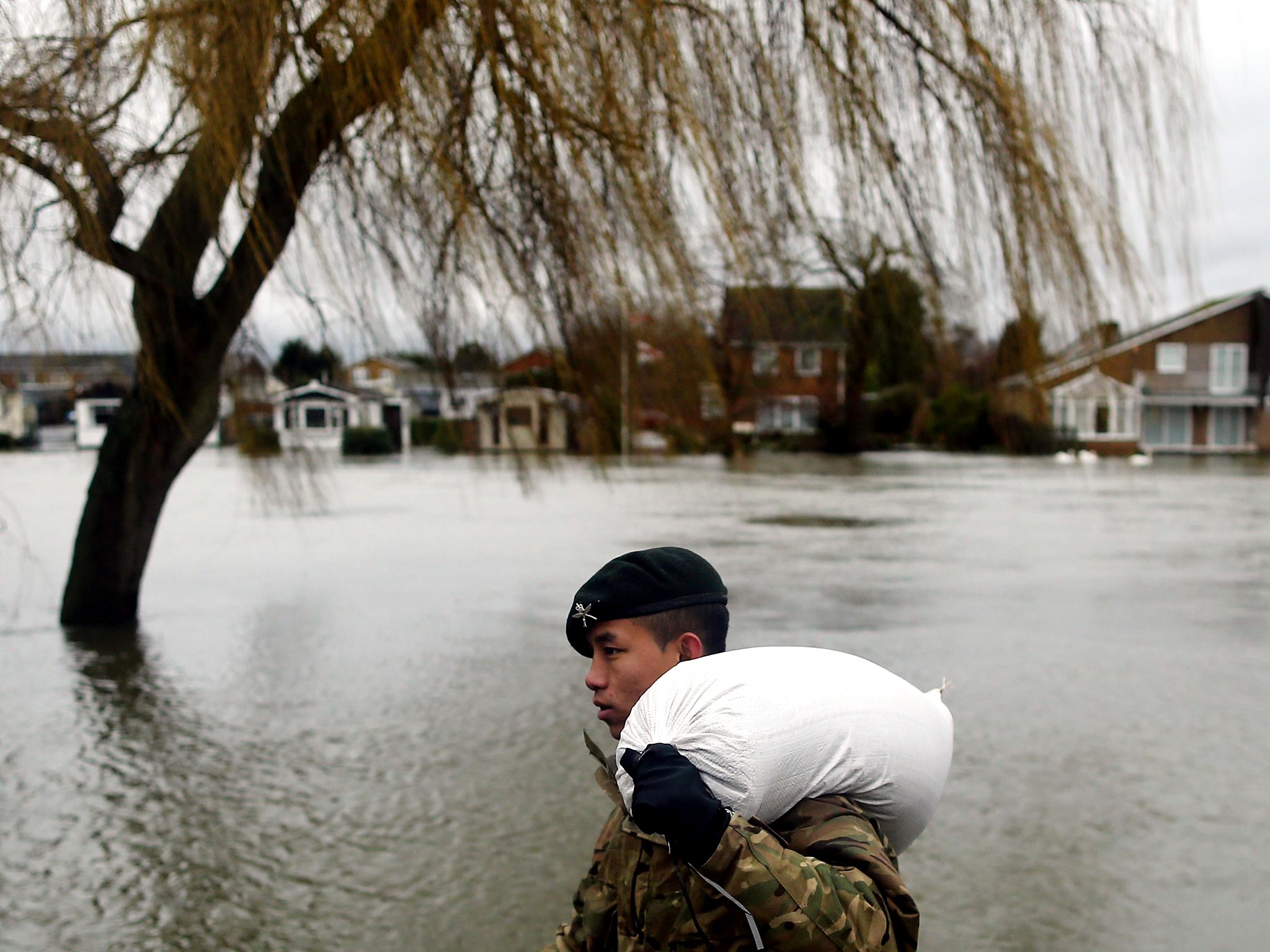When manicured riverside suburbs turn into a dystopia
Along the Lower Thames this week, J G Ballard’s imagined drowned world has not arrived quite yet. It is not far off


Your support helps us to tell the story
In my reporting on women's reproductive rights, I've witnessed the critical role that independent journalism plays in protecting freedoms and informing the public.
Your support allows us to keep these vital issues in the spotlight. Without your help, we wouldn't be able to fight for truth and justice.
Every contribution ensures that we can continue to report on the stories that impact lives

Kelly Rissman
US News Reporter
Something strange has happened at the bottom of Shepperton High Street. Walk down from the station and, at first, formulaic outer-suburbia unrolls – the dry cleaners, the cafés, the estate agents, the Indian restaurants, the branch library. The Three Horseshoes flies the Union flag over the pub garden. But the pub garden is now a lake. Waters lap at the foot of the war memorial. Beyond stretches an Everglades-like swampland of tree-studded pools and submerged roads.
Nearer to the grossly engorged Thames, the Red Lion – designated as a support centre for flood victims – is taking delivery of a truckload of sandbags. The Thames Meadow area is all Thames, and no meadow. Further on, the elegant span of Walton Bridge crosses not a single defined waterway but a sprawling, tentacular lagoon. To complete the eerie picture, a plump military helicopter chugs overhead, bringing a bizarre touch of wartime Indochina and its ravaged deltas to the supersized river.
Fans of cutting-edge fiction will spot that I didn’t begin a day beside the flooded Thames at Shepperton by accident. On Old Charlton Road, which runs up from the station towards a huge reservoir, the late J G Ballard lived for almost 50 years. When interviewers came to meet the creator of so many influential masterworks of science fiction and dystopian fantasy, they would invariably bang on about the contrast between his florid imagination and the humdrum setting of his home. As it happens, I think Ballard consciously overdid the “nondescript Shepperton” bit. Nearer to the river, it’s an older, prettier and more characterful place than that. All the same, it feels weird almost beyond belief to see some of the apocalyptic features of his most outlandish fiction invade the very place in which it was engendered.
In 1962, Ballard published The Drowned World – his second novel, and one of his finest. Thanks to the melting of the polar ice caps after “the continued heating of the atmosphere”, London has flooded into a network of steamy tropical lagoons in which rampant reptiles thrive. Along the Lower Thames this week, Ballard’s drowned world had not yet quite arrived. But the facts are serious enough: 1,000 flooded homes, as many people displaced, 14 severe flood warnings still in force and a military deployment that sends uniforms into the waterlogged streets of well-kept riverside suburbs. More than 21 inches of rain have fallen over the Surrey hills in recent weeks, feeding the peak flows of a river already close to the top of its banks.
I move on to Staines, where the Thames presents a formidable – and even scary – sight. Only the very tops of benches poke out above the drowned riverside paths. Oblivious to lapping reality, work continues on a new riverside office complex even though the car park that will serve it languishes under feet of water. On the opposite bank, the Swan Hotel has had local GP Dr John Pittard set up a temporary surgery there after flooding hit his usual one. However, the zone of astonishment remains a pretty narrow one. At Staines, I learned that the Spelthorne Leisure Centre had been earmarked as a sort of military-run holding camp for homeless victims of the floods. True enough, it emerged that the sports hall “may be used as a rest centre”. But all I saw in there were a couple of small boys merrily bouncing on a trampoline. Clutches of kids arrived for their post-school swim. Normality reigned.
The imagination of disaster never quite coincides with its reality. Along the Thames, perhaps, peculiar – and revealing – social factors have tilted our perception of the floods. Disgruntled victims of high water in the West and North suspect that a Home Counties prime minister will announce that “money is no object in this relief effort” only when the Thames threatens to engulf Michelin-starred gastropubs and the waterside mansions of celebrities. As if to confirm their doubts, yesterday Princes William and Harry staged a royal photo op and helped the sandbag-wielding troops at Datchet. They did not show their faces in December when the Humber burst its banks after a tidal surge to flood South Ferriby in Lincolnshire.
The whole idea of the Home Counties suggests a privileged border territory that swaddles the sacred capital. Indeed, the architecture of the Thames confirms this impression. I can never walk beside the imposing Edwardian locks at Teddington, where the Tideway begins, without thinking of a grandiose frontier post that guards the metropolis from harm. On London’s other edge, the 1984 inauguration of the (currently hyperactive) Thames Barrier completed the image of a zone of safety, stoppered at both ends. Even now there seems little danger of a repeat of 1928. Then, central London’s last great flood propelled torrents of water into the Houses of Parliament and drowned 14 poor people in the basement tenements of Lambeth.
So an element of Schadenfreude may kick in when people see cosseted regions in the grip of wild-weather perturbations. As that faithful Freudian J G Ballard knew, every fear is also a desire. Nonetheless, even the Home Counties are – at least along the turbid Thames – not quite as homely as all that. If you land at Heathrow in sunshine, sparkling waterlands stretch south of the airport – an intricate patchwork of reservoirs and waterways. In moments of extreme fatigue, say after an overnight long-haul from the east, you might even slip into the delusion that you have not yet left behind the rice paddies of tropical Asia.
In truth, this area has always been a waterworld. A cross-hatched landscape of cuts, channels, meadows, pools, gravel pits and reservoirs bears witness to centuries of riparian management. In Staines itself, the Colne meanders through protected water meadows conserved by the Metropolitan Commons Act of 1866. In 1857, the creation of the Thames Conservancy had given rise to the first systematic plans to harness the river’s flow. Significantly, the leisure of a booming suburban population as much as the needs of agriculture and transport would steer its policies. In the words of the 1885 Thames Preservation Act, “it is lawful for all persons for pleasure or profit or to loiter upon any and every part of the river”. Messing about in boats – or just in pubs – had explicit parliamentary sanction. Jerome K Jerome’s Thames-side classic Three Men in a Boat (1889) commemorates this new age of supervised waterborne fun.
The most recent major intervention, the Desborough Cut, was carved out in the mid-1930s, in part to mitigate flooding in Shepperton. But this week’s events have caught up with the latest improvement scheme. In 2010, the Environment Agency published its Lower Thames Flood Risk Management Strategy, designed to reduce danger to about 20,000 properties. It rested on the assumption of a once-in-a-century flooding incident. That event has just happened. If implemented, the strategy would widen the cuts, upgrade the weirs and dig three new flood-diversion channels. However you measure the future impact of climate change, this sounds like solid, sensible foresight – a candidate for David Cameron’s “money no object” largesse.
Yet Big Engineering may not always deliver the stoutest defences. At Kingston University, Dr Tim Harries specialises in flood research. He suggests smaller, cannier and even house-by-house reforms to enhance “resilience” now rather than wait for a one-off infrastructural fix. “The fix might come,” he told me, “but it won’t come for a while, and it won’t help everybody.” The EA’s strategy would take 10 to 20 years to complete. As extreme weather events increase, we need smarter alternatives to “very big, very expensive and very sacrificial schemes” from a past era of triumphalism. “Since the days of the Victorian engineers, we tend to think that we can conquer nature. That’s not the case, and it’s a big challenge.” Dr Harries worries that “we’re always talking about response and recovery. We’re not talking about adaptation”.
Instead, we could accept rising flows, and design riverside lives around them. “To make a home flood-resilient is quite difficult, emotionally and socially,” Dr Harries warns. “It would have to be accepted as characteristic of the area.” Future-proof floodplain houses would belong not to a zone of absolute safety but one of calculated risk. That might prove a tough call, along the Thames or elsewhere. “It’s so profound, because it has to do with how we see ourselves as people.” The carefree age of messing about around a controllable river may draw to a close. Over at Shepperton Studios, the roll call of box-office smashes filmed there includes almost every saviour and superhero fantasy from Superman to Thor by way of Harry Potter. Perhaps we still look for a caped crusader – or a youthful wizard – from politics or science to calm the raging torrents. Once the waters fall, it might be time to decide that the wand lies firmly in our hands.
Join our commenting forum
Join thought-provoking conversations, follow other Independent readers and see their replies
Comments